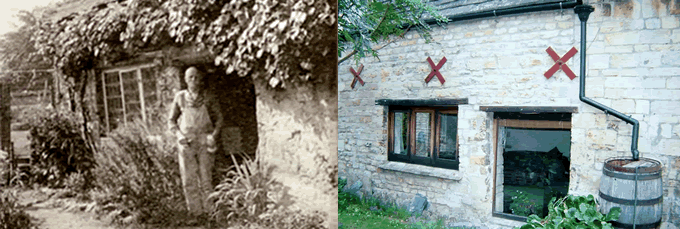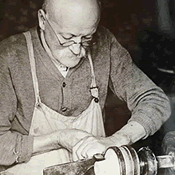 The Doomsday Book records the Northhamptonshire hamlet of Clive (Kings Cliffe) as, ‘standing in 4 acres of meadow with a wood a mile long by half a mile broad’. In medieval times the village was one of the ‘Twelve Forrest Villages’ within the 250 sq. miles of Rockingham Forrest, originally owned by the crown and used exclusively for hunting.
The Doomsday Book records the Northhamptonshire hamlet of Clive (Kings Cliffe) as, ‘standing in 4 acres of meadow with a wood a mile long by half a mile broad’. In medieval times the village was one of the ‘Twelve Forrest Villages’ within the 250 sq. miles of Rockingham Forrest, originally owned by the crown and used exclusively for hunting.
One of the earliest recorded woodturners was Nicholas Baylye who married in 1597 and there has been an unbroken succession of Baylyes (Baly, Bailey) employed in woodturning right through to the 1940s. In 1712 the writer Morton wrote, ‘there is scarce a town in England wherein this sort of handicraft is so much professed and is managed with so much dexterity’. Morton also noted that ‘wooden spoon making was a distinct trade’, but the handles of the spoons would have been turned. The 1762 militia list describes 26 of it’s able bodied men as woodturners. The major output of these Woodturners was domestic woodware, and up to the early 19th century probably only serving a fairly localized market.
Kings Cliffe still typifies the quintessential English village. A fine church dominates winding streets lined with a mix of fine mellow stone houses and humble cottages. The mill still stands by the trout stream, farms and meadows and an old pub (now a private house) called the ‘Turners Arms’ still survive. By the early 19th century the population of the village had nearly doubled from 876 (1801) to 1,407 by 1851 reflecting the growing prosperity of what was by now becoming a small market town. The census for that year reflected the importance timber played in the local economy. Recorded were; 3 timber merchants, 8 sawyers, 8 wheelwrights, 6 Carpenters, and 37 Turners. Of these, 5 bore the name of Bailey and all but 4 of the 37 were born in the village, an indication of the indigenous nature of the trade. When Mr. Levi Dixon entered the trade aged 12 in 1844 he did his apprenticeship on a pole lathe although by this time the wheel lathe would have been more commonly used.
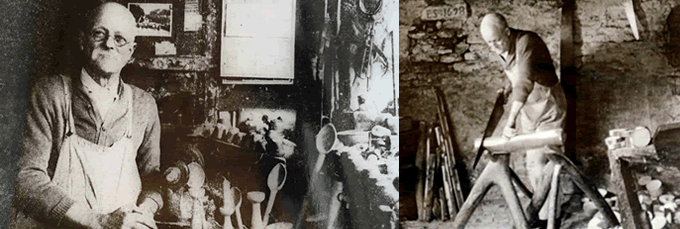
The populace was keen to have the railway stop at the village, which it did in 1879. A local newspaper, in petitioning for the railway stated in 1860, ‘if we turn to the woodware we see that hampers of it have to be bumped about on the road and half spoilt before they get to Stamford and Oundle markets’.
Writing in 1909 a Mr. EE Sibley wrote of a hawker named William Daking who died in 1840 aged 85. ‘It was his custom to purchase the woodware made by the Kings Cliffe turners, load up his donkeys with it and journey into different parts of the British Isles selling these wares, returning to Cliffe for fresh supplies or ordering them to be sent to different parts of the country. Dakin drove such a thriving business that he amassed a considerable fortune—. In those days the wood turning industry in Kings Cliffe was very flourishing, not only were large firms employing numerous journeymen, but there was a lathe in almost every house in the village (a slight exaggeration).The turner made great stocks of turnings in the winter months and in the spring the hawkers would arrive and practically clear the workshops and their stores. Bailys and others used to take wagon loads of articles to Peterborough Bridge fair, but the hawkers who went on the road from town to town or village to village were the main support of the Kings Cliffe industry’.
The woodware trade reached it’s height around the mid 1800s and by 1900 only 6 woodturners were still at their lathes. Pole lathes and Wheel lathes were both used. Some gas and steam driven machines are also said to have been utilized in the late 19th century.
The businesses were organized in small family units, they eventually being left to the eldest son who would have served his 7-year apprenticeship under his farther. This was the case with the Bailey family. Eighth generation woodturner John Bailey (1800-1858), also landlord of the Red Lion pub left his woodturning and carving business, J Bailey and son, to his eldest son John (1829-99). Another son, Thomas, also worked for the family firm for a time. Eventually Thomas became landlord of the Turners arms pub, this had an adjoining workshop at the rear. In due course Thomas left the pub tenancy and his woodturning business to his son William Henry Bailey (1868-1941) who eventually became the last woodturner in Kings Cliffe.
The type of woodware produced over the centuries would have changed in response to the varying demand and fashions. Little is recorded of the earlier output but such domestic items as Salts, cups and goblets, platters, dairy utensils and bowls would have been the mainstay. Wooden bowls were sometimes referred to as ‘basins’ locally when used for washing purposes. A specialty of Kings Cliffe was tiered spice boxes, each section being referred to as a ‘lift’. Each ‘lift’ or compartment was screw threaded varying from three to six compartments. These Sycamore spice boxes were produced in three diameters and in 1906 J Bailey and Son were wholesaling them from 7 shillings (35p) to 24 shillings (£1-20p) per dozen. In response to a bet one turner turned 417 eggcups in 8 hours, turning 63 during a one-hour period! Wooden spoons were still being produced by the tens of thousands, indeed Kings Cliffe was known for a long time as, ‘the wooden spoon’ village.
The favorite materials for turning appears to be Sycamore and Lime, but most local timbers were utilized including Maple, Beech, whitethorn, Birch, Chestnut, and Alder. Oak was used in the making of more expensive items such as candlesticks and Boxwood for the very best butter prints. Much of the work was turned ‘in the round’ from 6’ – 8’ (2-2 ½ m) long coppice or branch wood 3”- 6” (75mm-150mm) diameter. To aid drying it was shaved (debarked) and stored for a time under cover.
Apart from ‘between centres’ spindle turning, ‘Cup chucks’ were the normal method of holding blanks. The seasoned timber was sawn to length, then trimmed to size using a ‘peg knife’ (stock knife) hinged to a solid wooden block standing on 4 legs. The inside of the cup chuck was rubbed with chalk to aid grip as the turning blank was tapped into it. Few turning tools survive but those that do illustrate how basic they were. There seems to be a preference for short handles, sharpening being done on a hand cranked stone wheel. Boring in the end of such items as candlesticks was done using a hand held boring bit fixed in a block of wood shaped to fit in the palm of the hand.
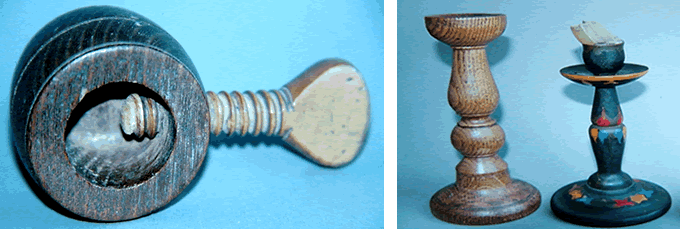
In the nineteenth century other materials such as cheap metal, china and glass goods were increasingly challenging Items made from wood. Responding to these changes the turners of Kings Cliffe began to specialize in items like carved butter prints and breadboards. In 1887 J Baileys received an order from Queen Victoria for a butter print with the royal coat of arms carved in boxwood. Taps and spigots for the brewery industry were made in by the thousand. There were 16 distinct operations involved with their manufacture with a skilled turner making between 2 and 3 dozen a day depending on size. Napkin rings, ladies powder bowls, egg cups, sugar sifters and candle sticks and similar items were made for the growing number of fancy goods shops. One turner, J. Ventross Green specialized in the making of toys.
During the second half of the 19th century there seems to be a shift away from dealing with the itinerant hawkers to working for more organized dealers, village men who worked in and knew the trade well. Firms like J Bailey and sons who collected orders from both wholesalers and retailers around the country and in turn organized the work to be produced by the local craftsmen. One member of the firm, Mr. A. Bailey would collect the orders from the turners. After inspecting and rejecting those that were not to standard he would carry out any carving that was required, particularly on breadboards and butter prints. Much of this work was then dispatched by train to the wholesale firm of McFarlane, Glasgow.
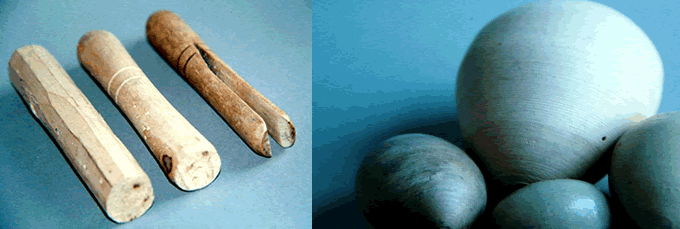
Of the 6 remaining wood turners still operating by 1906 one of the best known was William. H. Bailey, at the ‘Turners Arms, still serving beer by night and turning during the daylight hours in the adjoining earth floored stone workshop that was originally built in 1698. Apart from the usual woodware items William produced painted wooden eggs, thousands of them. These were imitation Pheasant, Partridge and Quail eggs used in the hatcheries to encourage the game birds to lay during the breeding season. ‘Pathe News’ featured William turning these eggs C.1936 as part of a feature on Kings Cliffe.
Another everyday item William turned for the local population was clothes pegs in Ash and Sycamore, some of these were discovered quite recently at the ‘Turners Arms’. In 1937 William devised what he called the ‘coronation whistle’. This became very popular in the locality by those with a sense of humor. It consisted of an eggcup like base with a threaded lid incorporating an extension that formed the mouthpiece to the whistle. Some small holes were bored in the front top of the lid, Fingers were held over these to blow the instrument. When handed to an unsuspecting ‘victim’ they would invariable hold it by the base and upon blowing the ‘whistle’ flour or soot was blown through the holes to cover their face. Simple fun at the ‘Turners Arms!
There are still descendants of the old woodturning families living in the village, Baileys, Buckland, Sharp and Dixon, but there is very little in the way of artifacts to be found amongst them or in the locality considering the long tradition of woodturning in the village.
I recently visited the old ‘Turners Arms’ (a private residence) and was invited by the present owners to view William Bailey’s old wood turning shop which is now a studio. Outside, the Oak beam still protrudes from the stone wall from which the pub sign used to hang. Painted on one side was the coat of arms of ‘’The Worshipful Company of Turners’. Next year is the 400th anniversary of the Worshipful Company and it is planed to have a new ‘turners arms’ sign hanging from the old building next year in commemoration. This will be the only physical evidence to visitors to Kings Cliffe of 4 centuries of wood turning.
